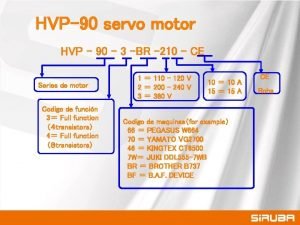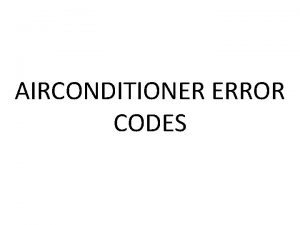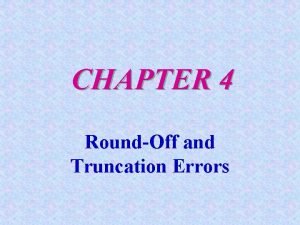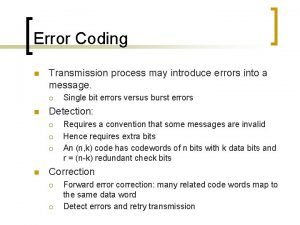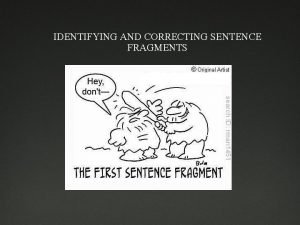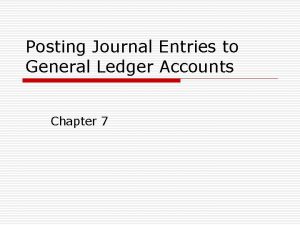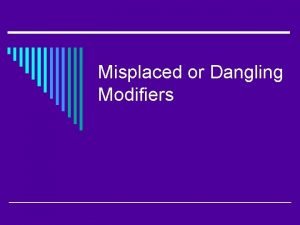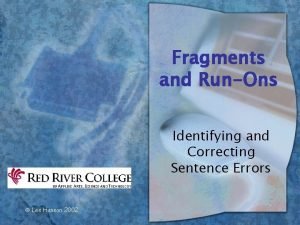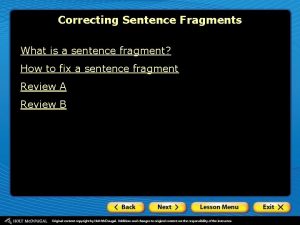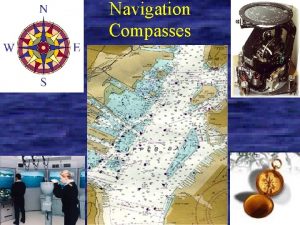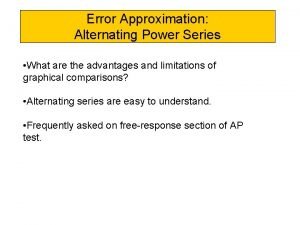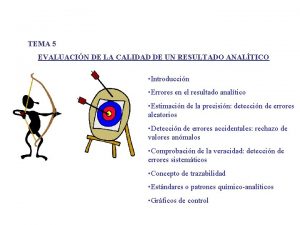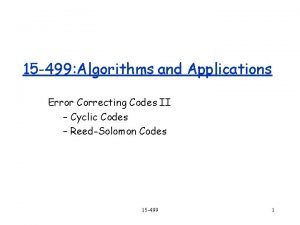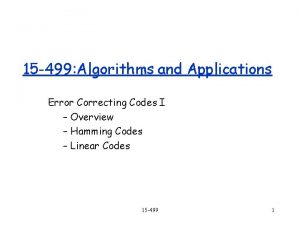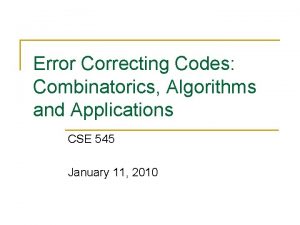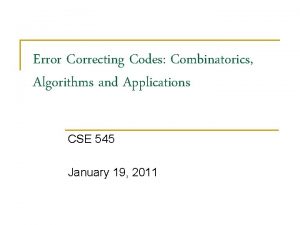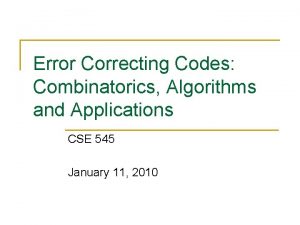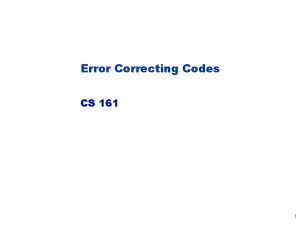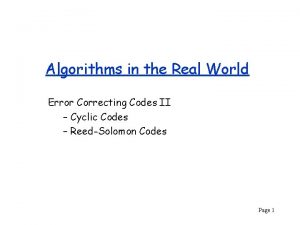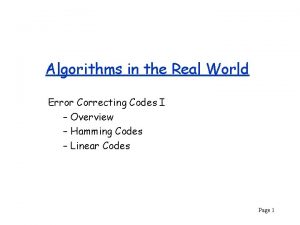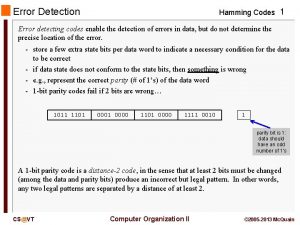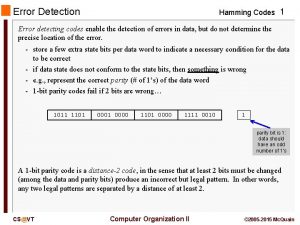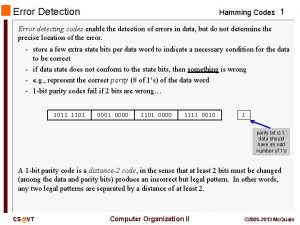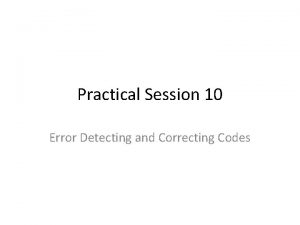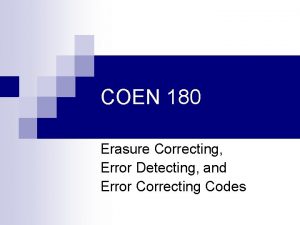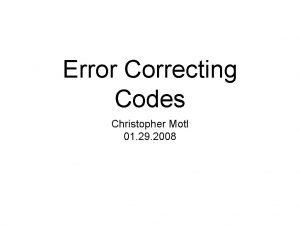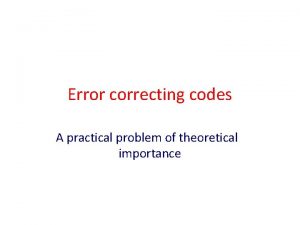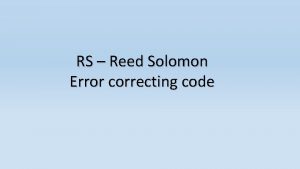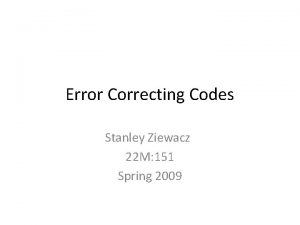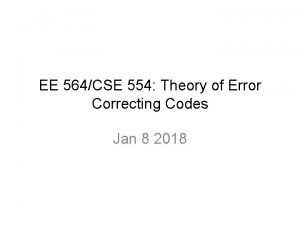15 499 Algorithms and Applications Error Correcting Codes































- Slides: 31

15 -499: Algorithms and Applications Error Correcting Codes – III - Expander graphs - Tornado codes - Expander codes 15 -499 1

Why Tornado Codes? • Desgined by Luby, Mitzenmacher, Shokrollahi et al • Forward Error Correction like RS & Linear codes • The other two give nearly optimal rates • But they are slow : Code Encoding Decoding Linear O(n 2) O(n 3) RS O(n log n) O(n 2) Tornado O(n log 1/e) 15 -499 2

The idea behind Tornado codes • Easy coding/decoding: linear codes with explicit construction • Fast coding/decoding: each check bit depends on only a few message bits 15 -499 3

Message bits Check bits c 6 = m 3 © m 7 Think of this as a “regular” Bipartite Graph Each message bit is used in only a few check bits => Low degree bipartite graph 15 -499 4

Properties of a good code • There should be “few” check bits • Linear time encoding – Average degree on the left should be a small constant • Easy error detection/decoding – Each set of message bits should influence many check bits – Existence of unshared neighbors 15 -499 5

Outline • Expander Graphs – Applications – Properties – Constructions • Tornado Codes – Encoding/Decoding Algorithms – Brief Analysis • Expander Codes – Construction – Brief Analysis 15 -499 6

Expander Graphs k bits (k·an) bk bits • Expansion property: every small subset (k·an) has many neighbors (¸bk) • Low degree 15 -499 7

Expander Graphs: Applications • Pseudo-randomness (Derandomization) • Error Correcting Codes • Communication networks – Peer-to-peer networks – Gossip based protocols – Loss-resilient networks 15 -499 8

Expander Graphs: Properties • Expanders are “pseudo-random” objects • If we start at a node and wander around randomly, in a short while, we can reach any part of the graph • Expander-based codes behave like random linear codes, but have fast constructions. 15 -499 9

Expander Graphs: Properties • Expansion can be characterized using the eigenvaules of the graph • A = normalized adjacency matrix • Maximum eigenvalue is 1. (Why? ) • Think of the eigenvectors as probability distributions • Second largest eigenvalue is an indicator of expansion – the smaller the better 15 -499 10

Expander Graphs: Properties • Prob. Dist. – p ; Uniform dist. – u • Small |p-u| indicates a large amount of “randomness” • Show that |Ap-u| · l 2|p-u| • Therefore small l 2 => fast convergence to uniform • Expansion b ¼ (1/l 2)2 15 -499 11

Expander Graphs: Properties • To show that |Ap-u| · l 2|p-u| • Let p = u + p’ • u is the principle eigenvector • p’ is perpendicular to u Au = u Ap’ · l 2 p’ • So, Ap · u + l 2 p’ • Thus, |Ap - u| · l 2|p’| 15 -499 12

Expander Graphs: Constructions • Important parameters – size, degree, expansion • Randomized constructions – A random d-regular graph is an expander with a high probability – Choose d random perfect matchings – Time consuming and cannot be stored compactly • Explicit constructions – Cayley graphs, Ramanujan graphs etc – Typical technique – start with a small expander, apply operations to increase its size 15 -499 13

Expander Graphs: Constructions • Start with a small expander, and apply operations to make it bigger while preserving expansion • Squaring – G 2 contains edge (u, w) if G contains edges (u, v) and (v, w) for some node v – A’ = A 2 – 1/d I – l’ = l 2 – 1/d Size – d’ = d 2 - d Degree Expansion 15 -499 14

Expander Graphs: Constructions • Start with a small expander, and apply operations to make it bigger while preserving expansion • Tensor Product – G = Ax. B nodes are (a, b) 8 a 2 A and b 2 B – edge between (a, b) and (a’, b’) if A contains (a, a’) and B contains (b, b’) – n’ = n 1 n 2 Size – l’ = max (l 1, l 2) Degree – d’ = d 1 d 2 Expansion 15 -499 15

Expander Graphs: Constructions • Start with a small expander, and apply operations to make it bigger while preserving expansion • Zig-Zag product – “Multiply” a big graph with a small graph n 2 = d 1 d 2 = d 1 15 -499 16

Expander Graphs: Constructions • Start with a small expander, and apply operations to make it bigger while preserving expansion • Zig-Zag product – “Multiply” a big graph with a small graph Size Degree Expansion 15 -499 17

Outline ü Expander Graphs – Applications – Properties – Constructions • Tornado Codes – Encoding/Decoding Algorithms – Brief Analysis • Expander Codes – Construction – Brief Analysis 15 -499 18

The loss model • Random Erasure Model: Each bit is lost independently with some probability m • We know the positions of the lost bits • Error Correction can be done with some more effort 15 -499 19

Tornado codes: Encoding • Why is it linear time? m 1 Computes the sum modulo 2 of its neighbors m 2 c 1 m 3 ck mn 15 -499 20

Tornado codes: Decoding • Assume that all the check bits are intact • Find a check bit such that only one of its neighbors is erased m 1 m 2 c 1 m 1+m 2+c 1 = m 3 ck mn 15 -499 21

Tornado codes: Decoding • Need to ensure that we can always find such a check bit • “Unshared neighbors” property Consider the set of corrupted message bit and their neighbors. Suppose this set is small. => at least one message bit has an unshared neighbor m 1 m 2 c 1 ck mn 15 -499 22

Tornado codes: Decoding • Can we always find unshared neighbors? • Expander graphs give us this property • Also, [Luby et al] show that if we construct the graph from a specific kind of degree sequence, then we can always find unshared neighbors. 15 -499 23

What if check bits are lost? • Cascading – Use another bipartite graph to construct another level of check bits for the check bits – Final level is encoded using RS or some other code n bn b 2 n bkn ¼ n 15 -499 24

Cascading • Total length of the code = n+bn+b 2 n+… · n/(1 -b) • Thus, rate is (1 -b) • Encoding time – for the first k stages : |E| = d x |V| = O(n) – for the last stage: n x n = O(n) • Decoding time – start from the last stage and move left – again proportional to |E| 15 -499 25

Outline ü Expander Graphs – Applications – Properties – Constructions ü Tornado Codes – Encoding/Decoding Algorithms – Brief Analysis • Expander Codes – Construction – Brief Analysis 15 -499 26

Expander Codes • Input: Regular expander G on n nodes, degree d Code C of block length d, rate r, rel. distance d • Output: Code C(G, C) of block length dn/2, rate 2 r-1, rel. distance ¼ d 2 • Linear time encoding/decoding 15 -499 27

Expander Codes: Construction • We associate each edge in G with a bit of the code • For every vertex, the edges around it form a code word in C • Block length = number of edges = nd/2 110 2 C n=6 d=3 001111010 2 C(G, C) 15 -499 28

Expander Codes: Construction • Linear code C has rate r => there are (1 -r)d linear constraints on its bits (these constraints define a linear subspace of dimension rd) • Total number of constraints in the entire graph G = (1 -r) nd • Total length of code = nd/2 • => Total number of message bits = nd (r-1/2) • Therefore, rate is 2 (r-1/2) = 2 r-1 15 -499 29

Expander Codes: Construction • For linear codes, the minimum distance between two code words = minimum weight of a code word • Intuition: If the weight of a code word is small, then the weight of edges around some vertex is small => distance of C is small => contradiction 15 -499 30

Expander Graphs: Construction • Expander graphs: Any set of an nodes must have at most m = (a 2 + (a-a 2) l/d) dn/2 edges • So, a group of m edges must touch at least an vertices • One of these vertices touches at most m/2 an edges • But these should be at least dd for the code to be valid • So, (a + (1 -a) l/d) d > dd => a > (d - l/d)/(1 -l/d) • Minimum distance is atleast a (a + (1 -a) l/d) ¼ d 2 15 -499 31
 Sap emm
Sap emm 20 minutes
20 minutes Simple key loader (skl) basic usage
Simple key loader (skl) basic usage Ho hsing control box error code
Ho hsing control box error code Taski service tool download
Taski service tool download Galanz f6 error
Galanz f6 error Good documentation practices poster
Good documentation practices poster Xgenus error codes
Xgenus error codes Mettler toledo ind331 error codes
Mettler toledo ind331 error codes Migatronic error codes
Migatronic error codes Enteral parenteral beslenme
Enteral parenteral beslenme Ims abend
Ims abend Automated commercial environment software
Automated commercial environment software Type 1 error and type 2 error in statistics
Type 1 error and type 2 error in statistics Absolute or relative error
Absolute or relative error Round off error
Round off error Difference between error detection and error correction
Difference between error detection and error correction Volume uncertainty
Volume uncertainty I have always enjoyed reading the book more than
I have always enjoyed reading the book more than Identifying sentence fragments
Identifying sentence fragments Business communication chapter 6
Business communication chapter 6 Problem 7-2 posting from the general journal to the ledger
Problem 7-2 posting from the general journal to the ledger Monitoring comparing and correcting work
Monitoring comparing and correcting work What is a dangling participle
What is a dangling participle Awubist
Awubist How to fix a sentence fragment
How to fix a sentence fragment Type 1 error vs type 2 error example
Type 1 error vs type 2 error example Can dead man vote twice
Can dead man vote twice What is a null hypothesis
What is a null hypothesis Power series form
Power series form Error sistematico
Error sistematico Error aleatorio
Error aleatorio



